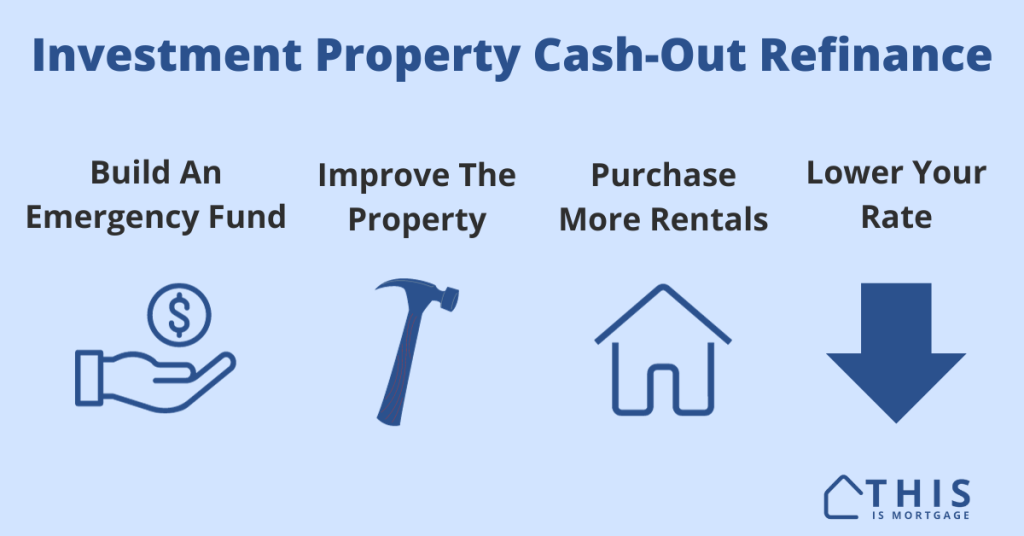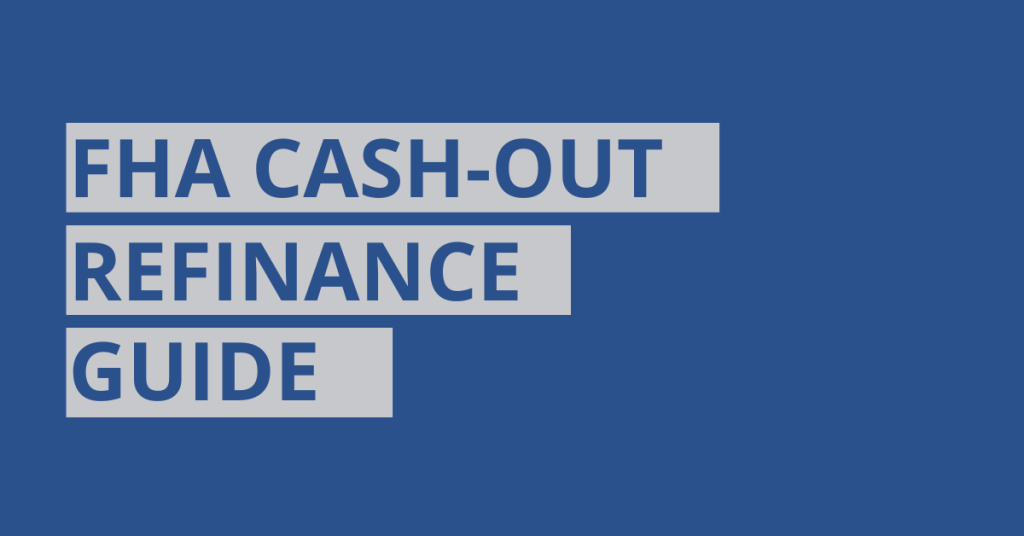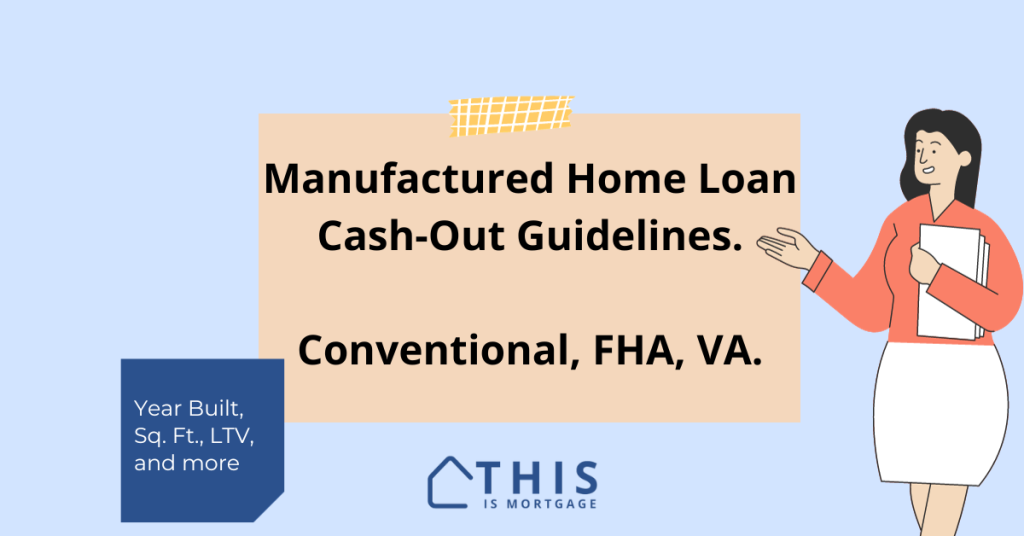As a rental property owner, you’re probably pleased to see that the value of your investment property has risen since 2020.
You could easily be sitting on $100,000 or more in tappable equity.
So, are cash-out refinances on rental properties allowed?
The answer is a resounding “yes.” Lending agencies Fannie Mae and Freddie Mac allow you to cash out your rental property to certain limits.
Let’s see how to tap into your equity and what you can use that cash for.
Start your rental property cash-out refinance.
- Maximum loan-to-value (LTV) on a rental property cash-out refinance
- Equity needed for a cash-out refinance on a rental property
- Get a value estimate before applying
- The loan process
- Finding a lender
- Qualifying for a rental property cash-out loan
- Mortgage rates for a rental property cash-out refi
- Uses for the cash
- Pros and cons of a rental property cash-out refi
- Rental cash-out refinance tips
- FAQ
- Should you get a cash-out refinance on a rental property?
Maximum loan-to-value (LTV) on a rental property cash-out refinance
I purchased a rental property in 2019 for $310,000 and by 2021 it appraised at $460,000. I took out a cash-out refinance of more than $100,000 on it. Because of this experience, I can give some real-world advice on the process.
First, how much can you borrow? Note that Fannie Mae and Freddie Mac both have the same maximum LTV guideline.
| Rental property type | Cash-out refinance max loan-to-value (LTV) |
|---|---|
| 1-unit home, condo, or townhouse | 75% |
| 2-4 unit property | 70% |
Here are some examples of maximum loan amounts at various rental property values
| Home Value | 1-unit max loan | 2-4 unit max loan |
|---|---|---|
| $150,000 | $112,500 | $105,000 |
| $200,000 | $150,000 | $140,000 |
| $250,000 | $187,500 | $175,000 |
| $300,000 | $225,000 | $210,000 |
| $400,000 | $300,000 | $280,000 |
| $500,000 | $375,000 | $350,000 |
| $750,000 | $562,500 | $525,000 |
| $1,000,000 | $750,000 | $700,000 |
See if you’re eligible for a cash-out refinance.
Equity needed for a cash-out refinance on a rental property
You should have at least 35-50% equity in the property before a cash-out refinance is worth it, depending on the dollar value of the home. High-value homes may need less equity to make a cash-out refinance worth it.
You need 25% equity in the property after taking cash out. So to get enough funds to justify closing costs, you need a lot more than 25% equity currently.
For instance, you have a 1-unit property worth $300,000 and currently owe $210,000 (30% equity). Your maximum cash-out loan is $225,000. So there’s $15,000 in cash available. But, there are $5,000 in closing costs, leaving you with $10,000 in actual cash.
Paying $5,000 in closing costs to get $10,000 is not worth it unless you can significantly drop your rate. Instead, you might look for a local credit union that will issue a low-cost home equity line of credit (HELOC) on the property, get a HELOC on your primary residence, or apply for a personal loan.
If your mortgage balance is only $100,000 on a $300,000 home, you could potentially get more than $100,000 in cash for $5,000 in closing costs. That’s a much better deal.
Tip: It’s okay to take a little extra cash if your closing costs are low and you can drop your rate at the same time. On my cash-out, I dropped my rate by 1%, so the refinance served two purposes.
Get a value estimate before applying
Home prices are dropping in many areas. You might assume the property is worth a certain amount. But if it doesn’t appraise for that much, the refinance may not be possible.
Before you incur the cost of an appraisal ($400-$800+), ask your lender if they can run a value estimate.
Or, ask for a Realtor’s price opinion of the property.
Make sure your value estimate is grounded in reality before spending time and money on the refinance.
The loan process
If you’ve decided that a cash-out refinance is worth it, the process is similar to when you bought the property or last refinanced it.
- Apply with a lender and let them pull your credit.
- Submit pay stubs, W2s, tax returns, bank statements, and other documentation if needed.
- Submit the lease agreement if required by the lender.
- Have the lender order the appraisal. Decide on a final loan amount if the appraisal comes in higher or lower than you expected.
- Supply any conditions the lender asks for.
- Sign final loan documents.
- At loan closing, the lender will wire loan proceeds into an account of your choice.
Speaking from experience, it’s rather exhilarating and a little surreal to see $100,000 show up in your account, simply based on theoretical value of the property.
Start your rental property cash-out refinance.
Finding a lender
Hopefully, you are in no rush for the cash and you can shop around for the best rates and fees.
It’s important to get 3-4 quotes from various lenders to make sure you’re getting the best deal.
Don’t simply go to the bank where you have a checking account. Try banks, credit unions, and non-bank mortgage lenders.
Another great source is a mortgage broker. Brokers aren’t tied to a single bank or company. They can shop dozens of companies to find the best rate and fee structure.
Contact a lender for a rate quote here.
Qualifying for a rental property cash-out loan
Rental property cash-out refinances are harder to qualify for than a purchase or standard refinance. That’s because the lender is actually giving you extra cash with no strings attached except to make the payment.
Here are some quick criteria you’ll have to meet.
1. Cash reserves
The amount of cash reserves you need depends on how many rental properties you have.
- 1-4 financed rental properties: 2% of all combined unpaid loan balances
- 5-6 financed rental properties: 4% of all combined unpaid loan balances
- 7-10 financed rental properties: 6% of all combined unpaid loan balances
Do not count your primary home, the property you’re refinancing, or property that is pending sale. You may not use cash proceeds from the refinance toward cash reserves.
2. Income
You will need adequate personal income to qualify for the new payment. The lender will take into account payments for your primary residence, car loans, student loans, and any other debt obligation. You can use rental income from the property. Supply lease agreements and/or tax returns depending on the situation. The lender will also order an appraiser’s professional rent analysis.
3. Debt-to-income ratio
Typically, your debt payments should be no more than 43% of your income, but may need to be lower, depending on the rest of the scenario. Remember that a conventional cash-out refinance on a rental property is the hardest loan to qualify for of any major loan type.
4. Credit score
You’ll need a minimum 620 score, but that doesn’t mean you’ll automatically be approved. Fannie Mae or Freddie Mac will look at the whole scenario to come up with an approval decision. To improve your chances and get the best rates, you should have a 700+ score.
See how much cash you’re eligible for.
Mortgage rates for a rental property cash-out refi
Mortgage rates for these loans are much higher than for a no-cash-out refinance or a home purchase.
Fannie Mae and Freddie Mac add Loan Level Price Adjustments, or LLPAs, to the loan, increasing the rate.
For example, here are LLPAs for a 75% LTV cash-out refi on an investment property for someone with a 700 score. Keep in mind these are displayed in points (a point is 1% of the loan amount).
You can pay points in cash, roll them into the new loan, or take a higher rate to cover them. Generally, each 1.0 point can be covered by a 0.25% increase in rate, but it depends on the lender and the market at the time.
| Loan Feature | Points |
|---|---|
| 700 FICO score / 75% LTV | 1.0 |
| Investment property | 2.125 |
| Cash-out | 1.0 |
| Total | 4.125 |
On a $300,000 loan, to cover the 4.125 points, you need to either take a 1.5-2.5% higher rate or pay an extra $12,375 upfront. Most people choose to take a higher rate, which is why investment property cash-out loans are known for having much higher rates than for the initial property purchase.
Keep in mind that the 2024 mortgage rate market isn’t normal. Often, lenders aren’t issuing “premium pricing”, meaning you can’t roll extra points into the rate but must pay them in cash.
If you encounter this situation, shop around for lenders and talk to a mortgage broker, who has access to multiple lenders. If one lender can’t roll the extra points into the rate, it’s possible that another lender can.
Uses for the cash
- Improve the property to yield higher rents.
- Purchase another rental property.
- Pull money out of one property to improve other properties.
- Raise cash to pool with partners to buy a multifamily building.
You can use the cash to make your property more desirable and keep the renter in place. Every day that you don’t have a tenant, you’re losing money.
As an example, I used part of my cash-out funds to put air conditioning in both of my rental homes. The summer after I did, the area experienced many 100+ degree days (not typical for western Oregon, but becoming more common). The A/C was a huge benefit for the tenants and kept them from finding a place with A/C.
Pros and cons of a rental property cash-out refi
Pros
- Turn “on-paper” home equity into real dollars.
- Use funds to expand your property portfolio, improve a property, or invest in other opportunities
- Can be less expensive than using a personal loan or credit card
- Extra interest paid (due to higher loan balance) may lower your tax obligation on rental income
- Keep extra funds in reserves in the case of a recession or other event leading to extended vacancy
Example “Pro”: $50,000 in cash out can be used to put 25% down on a $200,000 property, a great use of cash-out funds.
Cons
- High closing costs. Need significant equity and cash out to justify expense
- Your rate will probably increase
- Your payment will likely rise. Be sure the property still cash flows.
- Money taken out should be invested wisely. Otherwise, you pay extra interest for no gain elsewhere.
Example “Con”: You refinance out of your current 4% loan into a new cash-out loan at 6.5%.
Rental cash-out refinance tips
Here are some tips when getting a rental property cash-out refinance.
Let your tenants know about the appraisal: The appraiser will need interior access. Give your tenant notice required by law. Let them know you are not selling the home; the appraisal is just for a refinance and nothing will change on their lease.
Clean up the exterior and ask the tenant to tidy up inside: The appraiser will take pictures of the interior. Ideally, it’s clean inside, although a messy house won’t necessarily degrade your value.
Know the waiting periods: You must wait six months after purchasing the property to be eligible for a cash-out refinance. However, if you purchased the property in cash, the waiting period is waived.
Start your rental property cash-out refinance.
FAQ
You should have at least 35-50% equity in the home because you need 25% equity after taking cash out. Ensure that the cash received justifies money spent on closing costs.
You will have to wait six months before closing. However, you can apply ahead of time. You just can’t close until it’s been six months since the purchase. If you paid for the property in cash, you can close at any time with no waiting period.
Closing costs on a rental property cash-out refinance can be $5,000-$10,000 or more, depending on the loan amount, LTV, your credit score, and other factors. Lenders view these as riskier than no-cash-out refinances or home purchases and charge higher rates and points accordingly.
Removing equity from a rental property in the form of cash is a great idea if you use the funds to improve the property, purchase additional rental homes, pay off high-interest debt, pay off a hard money loan, or invest in other worthwhile endeavors. It’s not a good idea if you over-improve the property, take a vacation, or spend the money on something with a return lower than the interest you’re paying on the additional cash.
Should you get a cash-out refinance on a rental property?
A cash-out refinance can be a powerful tool to expand or improve your rental portfolio.
For me, the extra funds helped me improve my properties and make them more attractive to tenants. Plus, I was able to keep extra funds in reserve in the case of an extended vacancy.
Connect with a lender for an investment property cash-out analysis.




